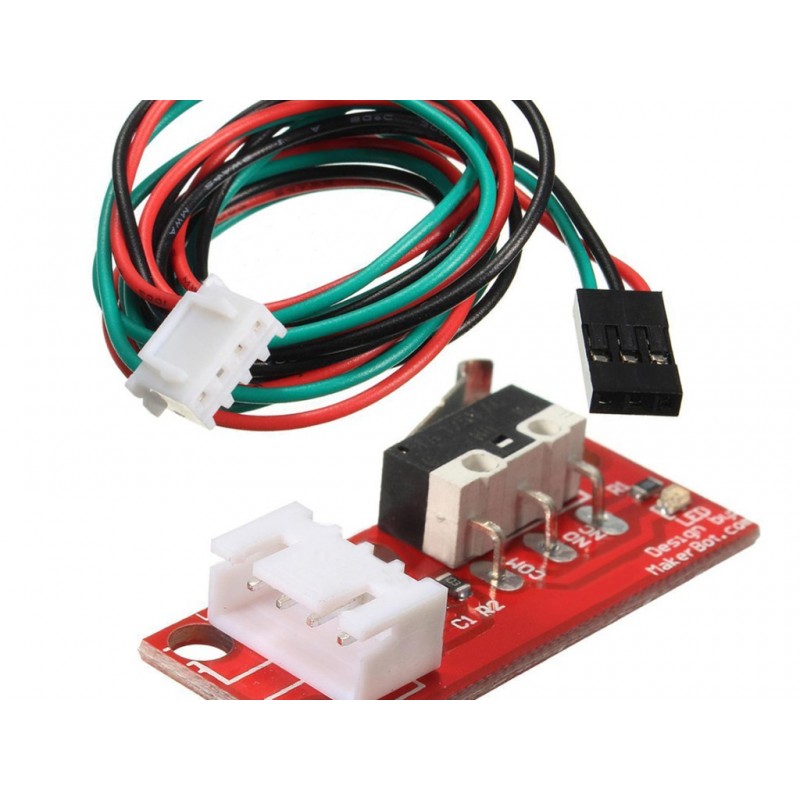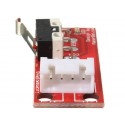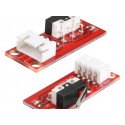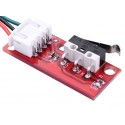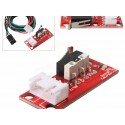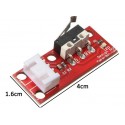-CNC 3D Printer Mech Endstop Switch uses a lever switch to detect when it is activated.
-The switch is wired up so that when activated, it pulls the signal to LOW.
-There is also an LED on the board that will light up when the switch is activated.
-It uses a standard 4 pin 100″ pitch header and accepts a standard, old-style CD-ROM audio connector cable.
-The mechanical endstop is a simple solution to a simple problem.
-We want to be able to detect when an X/Y/Z stage has reached its minimum or maximum.
-Instead of messing with flags or complicated light beam interruption, we use a mechanical switch.
-If we place the switch in the path of the stage, then the stage itself will simply close the switch when it moves against it.
-Other than properly positioning the switch, we do not need to modify the stage at all.
-If you’re worried about reliability, you can sleep well at night.
-The switches we use are rated for 1 million operations before failure.
-Since we only use the switches once per print, that means you’ll be able to do one million prints before having to replace the switch
Connection description:
Redline : connecting VCC (ramps of +)
Black line : connecting GND (ramps of -)
Green Line : connecting SIGNAL (ramps in s)
Features:
-Not easy to pull off, plug it convenient, for ease of use, plug the other side to do the one, you can use the direct plug.
-Quality switching elements.
-Customized high-quality connection wires using 22AWG copper wire with ratings of current 2A, 300V voltage.
-An insulating layer over a wide range of temperatures, up to 80 degrees.
| SPECIFICATIONS: |
|
| Operating Voltage |
300 V |
| Operating Current |
2 A |
| Temperature Resistance(°C) |
80 |
| OVERVIEW: |
|
| Wire type |
22AWG |
| Working voltage |
300V |
| Working Current |
2A |
| Temperature resistance |
80° C |
| Cable length |
70cm |
PACKAGE INCLUDES:
1 PCS x Endstop Switch With Cable For 3D Printer
//SOURCE CODE TAKEN FROM BELOW LINK
//https://www.electroniclinic.com/arduino-uno-limit-switch-tutorial/
int led = 13;
int flag = 0;
void setup()
{
Serial.begin(9600);
pinMode(Lswitch, INPUT);
pinMode(led, OUTPUT);
}
void loop()
{
if( (digitalRead(Lswitch) == LOW) && (flag == 0) )
{
Serial.println("door is closed");
flag = 1;
delay(20);
}
if( (digitalRead(Lswitch) == HIGH) && (flag == 1) )
{
Serial.println("door is opened");
flag = 0;
delay(20);
}
if ( flag == 1 )
{
digitalWrite(led, HIGH);
delay(1000);
digitalWrite(led, LOW);
delay(1000);
}
if ( flag == 1 )
{
digitalWrite(led, LOW);
}
digitalWrite(Lswitch, HIGH);
}
 9962060070
9962060070

